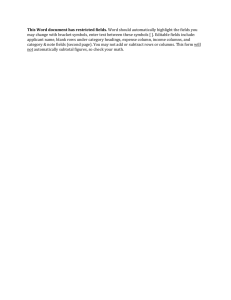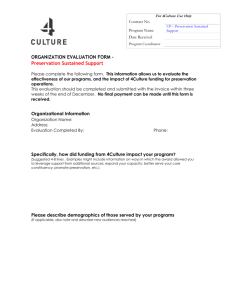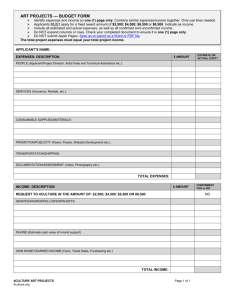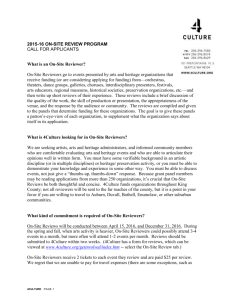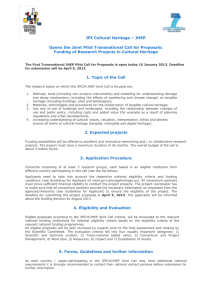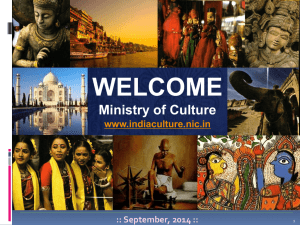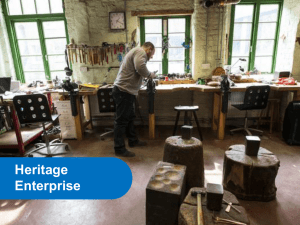Heritage Projects Grant Application Guide
advertisement
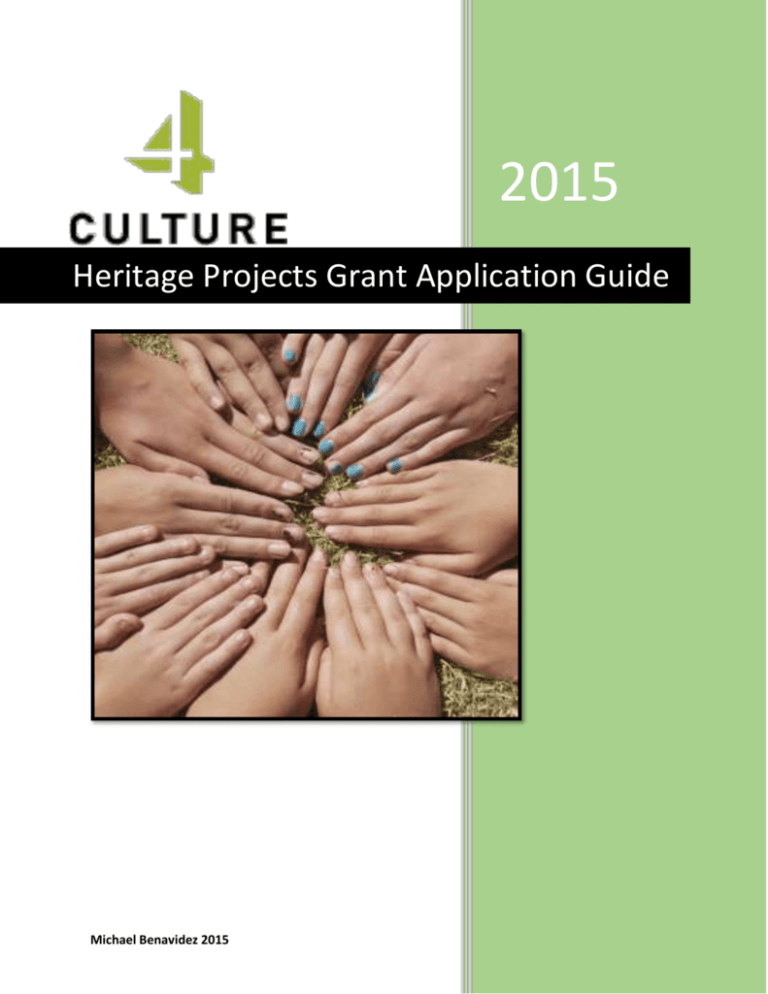
2015 Heritage Projects Grant Application Guide Michael Benavidez 2015 Table of Contents Overview ...........................................................................................2 Before You Apply ...............................................................................2 Eligibility _________________________________________________________________________ 2 Developing Your Budget ____________________________________________________________ 2 Creating a Narrative ________________________________________________________________ 3 Filling Out Your Application ................................................................4 Organization Section _______________________________________________________________ 4 Budget Submission _________________________________________________________________ 5 Narrative Section __________________________________________________________________ 6 Additional Files ____________________________________________________________________ 7 Submitting Your Application...............................................................7 References .............................................. Error! Bookmark not defined. Style Guide ........................................................................................8 Overview Hello, and thank you for deciding to submit a grant application to the 4Culture Heritage Projects funding program! King County depends on passionate, dedicated individuals like yourself and your organizations to enhance the character of our region by promoting and sharing the culture of the many diverse communities that call King County home. This guide is here to assist you in the process every step of the way, from determining the likely eligibility and basic needs of your project to assembling a completed application ready for online submission. Please follow each step carefully as you proceed–errors in submission are among the most common reasons for an otherwise compelling project to be denied funding. Before You Apply Eligibility It is imperative that you have a solid concept for your project before you even begin to fill out your application. This requires a defined goal you would like your project to accomplish. Examining the goal of your project is often the best way to determine if it meets the eligibility criteria of the 4Culture Heritage Projects program. 4Culture Heritage Projects promotes the identification, documentation, exhibition, and interpretation of historic and cultural materials pertaining to the heritage of King County, Washington. You may want to assess your project’s goal by weighing it against the following questions: Is your project historical or cultural in nature? Does the subject matter coincide with the greater heritage of King County? Are you identifying and promoting a subject relatively unknown to the average King County resident? If you can answer yes to all three questions, it is highly likely your project is eligible and should proceed with the application process. Developing Your Budget A thorough project budget is a required component for an application to be considered complete. You will need to specify how much funding you will need by submitting an estimated project budget to 4Culture. Consider all the potential expenses you may incur to meet your goal, such as: Costs of materials involved in your project Services of any professionals or experts you may require Land, usage, or other administrative fees Income from your organization that may offset or balance any of these expenses How to format your budget will be covered later–for now, know that 4Culture does offer its own budget form. Creating a Narrative In the previous sections we reviewed components that are mandatory for all applications. Here is where you will have the opportunity to highlight your project’s originality. Narratives are the most compelling part of any grant application–they present an opportunity to explain in your own words why funding your project will help meet the 4Culture Heritage Projects Mission–To promote the identification, interpretation, and exhibition of historic and cultural materials related to the heritage of King County. Your application’s narrative will be broken into several sections to better isolate the key qualities 4Culture is interested in learning about, so consider the following topics as you prepare: The impact your project will have on King County as a community Credentials and experience of people managing and contributing to the project The clear and present need for your project in King County How you will promote, market, and otherwise attract attention from the public for your work. Another important factor to keep in mind outside of your narrative: How well-known is your topic? 4Culture is most interested in bringing attention to areas that have been historically underrepresented, ignored or even suppressed. Compelling applications are often denied funds if the subject is perceived to already be well-supported in the community. This is not to discourage anyone from submitting an application, but only to ask that they be mindful of what they are asking for. Once you have proceeded carefully through the eligibility, budget and narrative steps of the pre-application process you will be ready to fill out the online application form. Filling Out Your Application Once you are ready to fill out your application the process is relatively straightforward: Go to the 4Culture Heritage Projects webpage and click the application link! Note that you will need to log into either your personal account or the account for your organization as a part of this process– review the website’s help section if neither has been set up. The following directions will guide you through each section of the application procedurally. Caution: We strongly suggest writing the application in a word document and then pasting the contents into the online application form so as to minimize technical difficulties while submitting. Organization Section In the organization section you will enter all information relevant to your organization or the group you are applying on behalf of. Many of the entries here are straightforward, (Address, Phone, Website, etc.) but there are a few items you may need to gather ahead of time: County and State Electoral Districts Incorporation Date Federal Tax ID WA State Unified Business Identifier (UBI) Total revenue for the last two fiscal years Director information should come next, followed by your organization’s mission statement, the project title, and a short description of the project. Consider the following for the last two items: Your project title should be both informative and short. Try to sum up the goal in four or five words. The description should similarly be no more than one or two sentences long, and cover the practical scope of what you would like to achieve (Ex. Hire a qualified archaeologist to excavate and document their findings at a historic abandoned farm). You will also need to enter your project’s total budget and the amount you are requesting with the grant. Preferably these values will not be the same–ideally you should be looking for no more than 50-60% of your project budget to be funded through the Heritage Grant. If you are following this guide completely then you may not have totaled your project budget yet. This offers a good opportunity to segue into the budget attachment form! Budget Submission 4Culture has its own budget form–downloadable from the website–that is recommended for all application submissions. However, you may use your own form if you or your organization has prepared a preferred format. This section categorizes and describes the various budget items 4Culture expects to see and should be included on any alternative budget form as well. Refer to the following image as you read this guide. 4Culture Heritage Projects Budget Form The budget form is divided between expenses on the left side and income on the right. Income is further divided between two sections: Organizational Matching and Requested 4Culture Support. You must total all costs related to your program or project in the expense section and then specify whether these costs will be met by your organization (or other sources of income) or if they will be paid for by the grant. Expenses are divided into the categories for bookkeeping purposes and ease-of-use: People: Costs paid to any personnel who will be working on your project. Includes compensation for organization staff, outside consultants and other key roles. Services: Fees for things such as insurance, rentals or professional services (transcription, scanning, etc) your project may require. Supplies/Materials: Any equipment or item purchases, but not equipment rentals (those would fall under services). Promotion/Publicity: Costs to market and raise awareness of your project. Examples include buying ad space, printing flyers and web design. Note that services related to marketing the project but not completing it would belong here. Other: Any items that do not fall into the aforementioned categories. At the bottom of the form is a section for notes where you may list particular items and elaborate on their purpose if necessary. Expand on any consultation or analytical services in this area to give the board a clear idea of what they will do for your program. Narrative Section The narrative section offers the opportunity to express a need and urgency for your project. For each section it is advised that you keep the length at no more than 500 words to help keep your ideas concise. Narratives are divided broadly into four segments; this guide will describe what the board is looking for in each section to better enable you to express your project’s goals, needs and originality. Project Description Provide a full description of the aim, scope, and relevance of your project to King County’s Heritage. The short description you wrote earlier in the application should be the base on which you build from in this section. Include specific objectives, locations, activities, and calendar dates, being sure to call out specific items as milestones in the progress of your project. You should also express a clear and urgent priority for why your project needs grant funding this year–the board is much more likely to approve funds for your project if they are convinced this their only chance to do so (Ex: Trying to record an oral history with elderly and ailing residents of a local neighborhood). Remember that the strongest proposals are shaped by need. Project Impact What is the intended effect you hope to achieve with your project? Which communities will be served and how will it improve public life? These are the questions your response will need to answer in the Project Impact section. This section represents a great opportunity to put a human face on your application by stating who will be impacted by your work. If possible, it is a good idea to include a short personal story here of an individual, family, or group of people in a community you know that either inspired or are the target beneficiaries of your project. Relevant Expertise Knowing the people working on your project is as important to your application as those you hope to benefit by it. In this section you will need to highlight the credentials and experience of your project manager, relevant consultants, contributors, and any other key positions that will have a significant influence on your project’s development. It is important that the grant board have confidence in the team (or individual) that they will be funding, so be sure to call out any and all relevant past work done by those involved in your project, especially those funded by 4Culture. Project Implementation This is where you will provide an estimated timeline for your project. In addition to reemphasizing significant milestones (Try to tie them to a date if you can), mention any work you have already begun. Projects that are already underway or past the planning stages are more likely to be approved. Remember to include any marketing, promotion, and publicity tactics you will use–the more professional, the better. Additional Files Although they are completely optional, it cannot hurt your case to attach letters of support from other organizations, existing disbursements from other grant funds (if any) and articles that have been written about your organization or work. These items all contribute to demonstrating a diversity of support, partnership and reputation for your organization that can serve you well when being considered for approval. Submitting Your Application Once your application is completed to your satisfaction, simply press the “submit” button at the bottom of the online application and confirm your choice. There will be a brief error check and your application will be submitted. If your application has an error, follow the site prompts to correct it–usually it is a required field that needs to be filled out. You can expect a response up to two months after the application window has closed. Thank you for you expressing interest in 4Culture Heritage Projects, and we wish you the best of luck on your project! Style Guide Fonts Font face and size will have consistent usage dependent on their usage, outlined as follows: Page Title & Table of Contents: Baskerville Old Face, Size 48 Section Headings: Calibri (Light), Size 20, Bolded Sub-Section Headings: Cambria, Size 14 Body Text: Calibri (Body), Size 12 Capitalization, Terms & Abbreviations Capitalization will follow all conventional usage, with the following additions: “4Culture Heritage Projects” will be used consistently and always capitalized as seen. Each word in page titles and sections headings will be capitalized. o Exception: Single characters and conjunctions will not be capitalized. 4Culture shall always be capitalized as seen when written. When referring to the actual grant fund the appropriate term is 4Culture Heritage Projects, but when broadly referring to the organization 4Culture may be used by itself. Abbreviations will be typed out in full on first usage, with the abbreviation in parentheses. The abbreviation will be used exclusively thereafter. Punctuation Apart from standard usage, punctuation conforms to the following rules: The serial comma shall always be used. An n-dash or semi-colon may be used when connecting two complete ideas. Items in bulleted lists will not be closed with periods unless they are complete statements/sentences. Paragraphs and Spacing Sections and sub-sections shall have one line of space above and below them. o More than one line of space is acceptable where a page break may otherwise impact readability. Grammar Avoid using contractions. While use of the second person is appropriate to refer to the reader in this guide, the first person is to be avoided.
